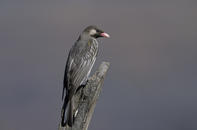
Name
Greater honeyguide - Indicator indicator
Greater Honeyguide Appearance
The greater honeyguide is around 20 cm in length. The greater honeyguide has dark brown to grey upperparts and white underparts, with a black throat and a white stripe on the side of the tail. The white cheeks and pink bill are diagnostic for the male greater honeyguide. Some males may show a yellow shoulder patch.
The female has duller plumage and no black throat and has a black bill. The female closely resembles a bulbul in appearance.
Greater Honeyguide Diet
The greater honeyguide feeds mainly on beeswax and also feeds on the other contents of a bee colony - bee eggs, bee larvae, bee pupae and bees. This honeyguide will eat other insects. Honeyguides are one of the few birds that can digest wax.
Like all honeyguides, the greater honeyguide will feed at an active bee’s nest in the early morning, when the bees are lethargic. They readily feed on abandoned hives and hives that have been disturbed or robbed by humans or other animals.
Greater Honeyguide Breeding
The greater honeyguide is a polygynous brood parasite that parasites a range of hole nest species. Their main hosts are bee-eaters, kingfishers, barbets and starlings. When laying in a host’s nest, the greater honeyguide female will commonly break the host's eggs. When hatching, the honeyguide chick has a hook on its bill to kill any of the host's chicks that are hatching at the same time.
Greater Honeyguide Behaviour
The greater honeyguide is known to guide humans to the nests of wild bees. The honeyguide will attract a person’s interest with a chattering call. The bird will then fly towards the bee nest in short flights, continually stopping and calling for the person to follow. When the bird arrives at the bee’s nest, it will display by, spreading its wings and indicating the location of the nest to the person being guided. Once the nest has been raided by the human, the honeyguide will then feed on the nest. This mutualistic behaviour has been observed in Kenya, Tanzania, Mozambique and with the hunter/gatherer tribes of the Kalahari.
There is a tribal tradition or myth that says the honeyguide needs to be thanked for leading the person to a nest, with a gift of honey from the nest. If this is not done, the tradition says, the next time the honeyguide will lead the person to a hungry lion, venomous snake or an angry elephant as punishment.
Threats
None.
Greater Honeyguide Distribution and Habitat
The greater honeyguide Is found in woodland and riverine forest in the eastern and northeastern areas of South Africa.